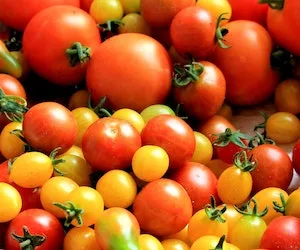
The Vibrant World of Tomatoes: An Expert’s Guide
Tomatoes, botanically known as Solanum lycopersicum, have carved a significant niche in our global food system. They are a culinary cornerstone, offering a unique blend of acidity, sweetness, and umami that elevates any dish. But there’s more to tomatoes than meets the eye – or the taste buds.
Varieties and Their Unique Traits
There are approximately 10,000 known varieties of tomatoes, each with its unique characteristics and flavor profiles:
-
Beefsteak Tomatoes: Renowned for their size and meaty texture, beefsteak tomatoes are often sliced for sandwiches or diced for salads. Their relatively low water content makes for a rich and robust flavor.
-
Cherry Tomatoes: These bite-sized wonders pack an exciting sweet punch. The high sugar concentration contributes to their sweetness, while the high skin to flesh ratio can lead to a slightly higher concentration of nutrients.
-
Heirloom Tomatoes: These tomatoes come in an array of shapes, sizes, and colors. Each has a unique flavor profile and may contain slightly different nutrient concentrations.
-
Roma Tomatoes: Also known as plum tomatoes, Romas are most often used in tomato sauces and paste because of their dense flesh and lower moisture content.
Chemical Composition and Health Benefits
Beyond their delicious flavors, tomatoes are a treasure trove of nutritional benefits, thanks to their rich chemical composition:
-
Vitamins and Minerals: A good source of vitamins A, C, and E, potassium, and folic acid. These micronutrients have been linked to a range of health benefits, from supporting immune function to maintaining good eye health and assisting in metabolic functions.^[1^]
-
Lycopene: This antioxidant is the star player in tomatoes. It gives them their distinctive red hue and has been linked to a reduction in heart disease and certain types of cancer. Interestingly, lycopene is more easily absorbed when the tomatoes are cooked or processed.^[2^]
-
Fiber and Carbohydrates: Tomatoes contain about 4% carbohydrates, largely in the form of simple sugars and dietary fiber. The fiber content aids in digestion and provides a feeling of fullness.
Growing Conditions
Tomatoes are warm-weather plants with varieties that can adapt to many different climates. The specific growing conditions, including the soil, weather, and care, can significantly affect the chemical composition and taste of the tomato. It’s why the same variety of tomato can taste slightly different depending on where and how it’s grown!
The Global Tomato
Tomatoes have a global presence. They play a crucial role in many world cuisines, from the Italian pomodoro sauce, the Spanish gazpacho, to the American hamburger. Their versatility, flavor, and nutritional benefits have made them an indispensable part of our global food system.
So next time you bite into a juicy tomato, remember that you’re partaking in a global tradition and nourishing your body with a powerhouse of nutrients and beneficial compounds.
References:
- USDA National Nutrient Database
- Story E.N., Kopec R.E., Schwartz S.J., Harris G.K. (2010). “An update on the health effects of tomato lycopene”. Annual Review of Food Science and Technology. 1: 189–210.
